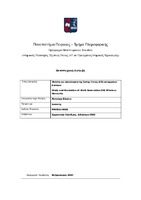Μελέτη και αξιολόγηση της Έκτης Γενιάς (6G) ασύρματων δικτύων
Study and evaluation of Sixth Generation (6G) wireless networks

View/
Keywords
5G ; 6G ; Τεχνητή νοημοσύνη ; Αυτοματισμός ; Πέρα από 5G ; Ρυθμός δεδομένων ; Μαζική συνδεσιμότητα ; Εικονική πραγματικότητα ; TerahertzAbstract
Fifth-generation (5G) communication systems have entered the development stage in recent years, providing users with improved services as well as a range of new capabilities across various industries. However, 5G still faces many challenges. To address these challenges, academics and organizations have initiated research into sixth-generation (6G) wireless communication systems. A number of studies have been published focusing on requirements, application scenarios, key technologies, and more.
As technology continuously evolves, 6G is beginning to enter the discussion. It is still in an early stage for implementation and widespread deployment, so studying and further scientific development of this technology is of great importance. There is no doubt that 6G networking will provide solutions to fundamental problems that remain unresolved. 6G technology will contribute to the advancement of communications, enabling connections with a vast array of systems, IoT devices, and more. 6G will be enhanced by the development of Artificial Intelligence at almost every level, from network integration and management to signal encoding and processing, smart infrastructure handling, and big data mining and processing.
Using electromagnetic frequencies above 95 GHz, future devices will be able to utilize a vast bandwidth, exceptional coverage, and new applications. The new frequencies in the sub-Terahertz bands will enable transmission across a broad spectrum, allowing future devices to have significantly greater capabilities. The future 6G device will be able to meet many more human needs, such as facilitating simultaneous communication between multiple devices and processing large volumes of data to enable faster and better decision-making.
The existing literature has identified many open questions regarding what 6G will be. This study provides an illustration of the 6G vision, technical requirements, and application scenarios, covering the current literature. A critical assessment of the 6G network architecture and key technologies is then presented. Additionally, existing tests are described. Furthermore, future research directions and challenges are identified. Finally, current experiences regarding 6G networks are outlined.
All these changes in communication technology (as with any change) also have implications for society itself, such as economic, ethical, and political issues. The key is not to become opponents of this scientific evolution but rather to consider how it can be utilized to truly address humanity’s expanding needs.

